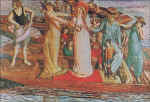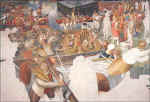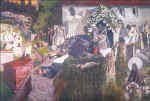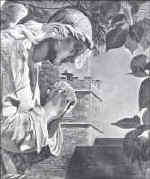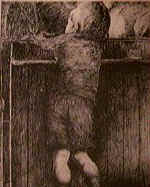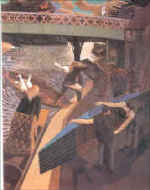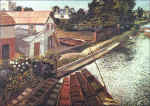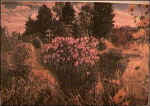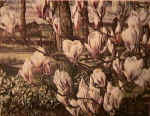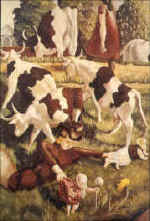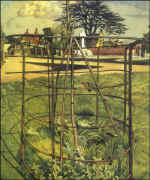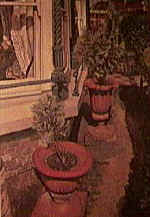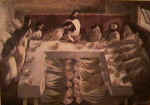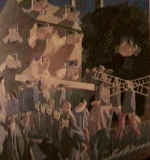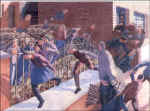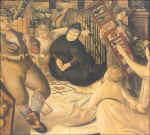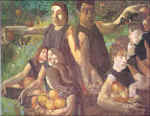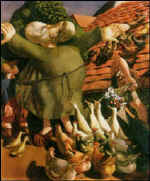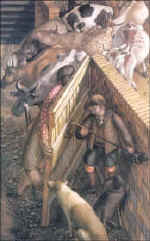|
Stanley Spencer Tour of Cookham |
||
|
|
||
|
The walk, which takes about an hour, starts on the corner of Cookham High Street opposite the Stanley Spencer Gallery. From the end of the High Street cross the main road to the Tarry Stone, painted by Stanley Spencer in 1929. Go down Odney Lane and take the first left, Ferry Lane, which leads to the river passing the Ferry Hotel on your left.
N.B. Larger images can be seen by clicking on the paintings. |
||
The river frontage of the hotel was the setting for the colourful painting Dinner
on the Hotel
Lawn,
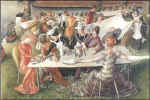 which
is now in the Tate Gallery.
This is the fourth of the Cookham Regatta series begun in 1952. The scene
takes place on the lawn of the Ferry Hotel by the side of the Thames. Here
the visitors prepare to eat their
dinner, listening to Christ preaching from the horse-ferry barge moored
further up river. Spencer was to comment on that the long tables, whose
shapes bear a passing resemblance to punts, occur only in this painting,
whereas those in others of the series are square. "In all of them I
seem to have forgotten the food, square or long tables. And I was annoyed
to notice that I had made the servants putting the knives on the wrong
side: and they are doing it so nicely." The gaily dressed crowds
which attended the Regatta in Edwardian times gave Spencer an ideal
opportunity to paint the elaborate and colourful clothes for which he had
developed a taste for in the 1930s. For Cookham's Millennium Celebration
in July 2000, this scene was reinacted by the Tarrystone Players. The
finale was the
final tableauwith Sir Stanley Spencer's grandson, John Spencer in the
process of painting the scene. which
is now in the Tate Gallery.
This is the fourth of the Cookham Regatta series begun in 1952. The scene
takes place on the lawn of the Ferry Hotel by the side of the Thames. Here
the visitors prepare to eat their
dinner, listening to Christ preaching from the horse-ferry barge moored
further up river. Spencer was to comment on that the long tables, whose
shapes bear a passing resemblance to punts, occur only in this painting,
whereas those in others of the series are square. "In all of them I
seem to have forgotten the food, square or long tables. And I was annoyed
to notice that I had made the servants putting the knives on the wrong
side: and they are doing it so nicely." The gaily dressed crowds
which attended the Regatta in Edwardian times gave Spencer an ideal
opportunity to paint the elaborate and colourful clothes for which he had
developed a taste for in the 1930s. For Cookham's Millennium Celebration
in July 2000, this scene was reinacted by the Tarrystone Players. The
finale was the
final tableauwith Sir Stanley Spencer's grandson, John Spencer in the
process of painting the scene.
If you turn to the right the river looks much the same as when it was depicted by Stanley Spencer. Notice the wall down the side of the lane, this forms the background to Dinner on the Hotel Lawn. It is an example of the artists' meticulous painting of brick surfaces. Other good examples can be seen in the paintings of Englefield House in the gallery.
Retrace your steps to Odney Lane and the entrance to the Odney Club owned by the John Lewis Partnership. In the wall fifty yards to the left at the entrance are some round windows like ship's port holes in front of which the artist painted Girls Returning from a Bathe (1936) now in the gallery.
Returning to the Tarry Stone, cross the main road and take the turning
leading to Cookham
Church. The young Stanley Spencer
was fascinated by the churchyard, he wrote about its vaults with heavy railings and the
leaning tombstones. It was there that he set one of his most important paintings,
The
Resurrection, Cookham. |
||
Stanley Spencer painted The Angel
(1953)
Although there are no paintings by Stanley Spencer hanging in the church, which has a largely medieval interior and is well worth a visit, he did set some of his work inside.
From the church take the path past the west door leading via a kissing gate to the river. Stanley Spencer wrote of being taken by his father to the kissing gate at twilight to hear the owls "snoring". At the towpath, turn right towards the bridge which Stanley painted crowded with people in 1920.
Just before the Sailing Club turn to the left up the path which runs between the club on your right and Cookham House on your left. But before doing so glance at the view ahead, still little changed, of the fields and the river bank; these were the settings for By the River (1935) and Cookham-on-Thames (1937).
Opposite the end of Berries Road is the War Memorial, erected in 1921. Among others it commemorates the death in the first World War of Sydney Spencer MC, one of Stanley Spencer's brothers. Here Spencer painted A Village in Heaven 1937, which is set on the edge of Cookham Moor by the War Memorial, where the village girls traditionally came to meet their lovers. One of the disciples stands by the Memorial and gives his blessing to the young lovers. Its theme is the redemption of the world by sexual love which has become free of all shameful associations. |
||
|
Spencer was often disparaging about landscapes like this, which took him away from the more important figure painting. It was painted before the onset of financial pressures of the late thirties and early forties, which sometimes caused him to cut corners in an attempt to provide an early saleable work.
|
||
|
The artist looked upon the High Street as the nave of a church and he made it the setting for many of his paintings. These include Christ Carrying the Cross, Christ's Entry into Jerusalem and Sarah Tubb and the Heavenly Visitors (1933) now owned by the gallery.
|
||
